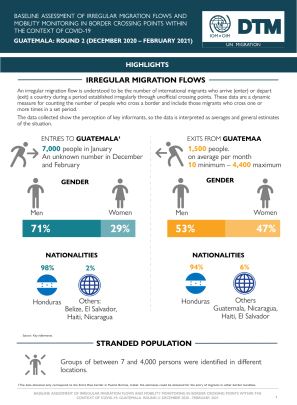-
Countries
-
Data and Analysis
-
Special Focus
-
Crisis Responses
Guatemala-Baseline assessment of migration flows and migrants presence within the context of COVID-19 report- #2 (December, 2020-February 2021))

Contacto
Walter Arreaga warreaga@iom.int
Idioma
English
Ubicación
Guatemala
Fecha de instantánea
Dec 01 2021
Feb 28 2021
Actividad
- Event Tracking
During the last few months, as a result of the COVID-19 pandemic and subsequently, the arrival of Hurricanes Eta and Iota in the region, the economic and labour crisis increased in the Central American countries. The new administration of the United States also had an impact, with the perception of migrant populations of the flexibilization of migration policies. Therefore, it has been observed that the topic of migration has gained greater relevance in the public opinion and in national media.
The migration flows that transit through Guatemala are composed of small groups, such as families, or large caravans originating in Honduras. The Government of Guatemala, in response to the migrant caravans, deployed military forces, antiriot police officers and police forces with the aim of stopping these massive migration flows. These control actions were implemented in 7 departments bordering with Honduras and El Salvador. The Government of Mexico took the same stance and secured the border with Guatemala to stop the crossing of irregular migrants and travellers without essential reasons to visit Mexico.
Thus, the dynamic of the mobility of caravans in transit through Guatemala was affected. Migrants enter through the southern border, at El Corinto or El Florido border crossing. As they travel from the Izabal route (southern border) toward El Ceibo border in Peten (northern border), the number of migrants decreases since some of them decide to return to their communities of origin.
